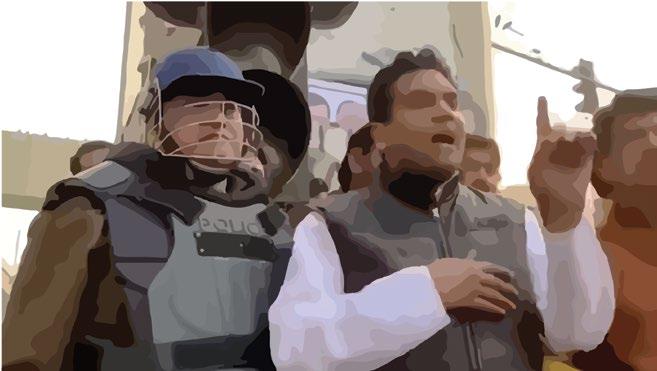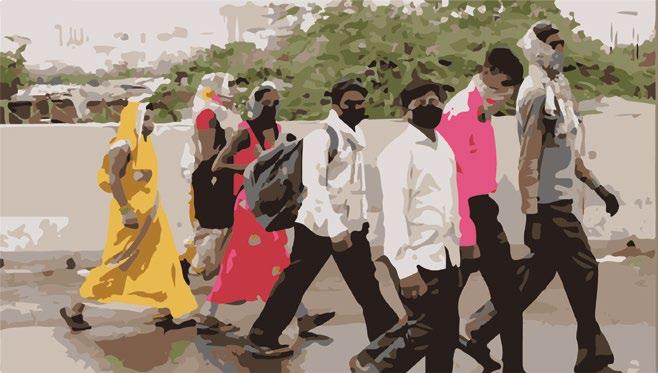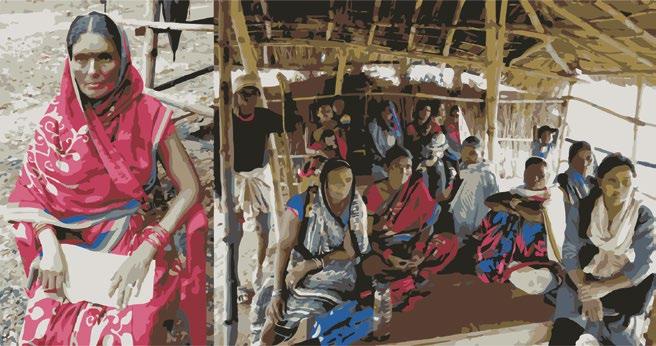
7 minute read
Hate Speech
24 year old Tabrez Ansari, tied up to the street light pole and beaten to death in Jharkhand. Police also complicit in the death by putting wounded Tabrez inside the cell, without medical help on time.
How hate speech sparks hate crimes in India
Black’s Law Dictionary, (9th Edition) defines the expression ‘hate speech’ as “Speech that carries no meaning other than the expression of hatred for some group, such as a particular race, especially in circumstances in which the communication is likely to provoke violence.”
In India, hate speech plays a key role in instigating hate crimes. These are crimes committed against members of specific communities who are singled out and targeted with the intention of intimidating them. Usually hate speech is replete with communal slurs often related to stereotypes associated with the community being targeted. Though hate speech has been around for a long time,1 it has become more frequent since May 2014, and is used as a tool to incite hatred, violence, animosity, particularly towards minority communities with the aim to establish dominance of the majority.2 Democracy thrives on disagreements provided they do not cross the boundaries of civil discourse. Critical and dissenting voices are important for a vibrant society. However, care must be taken to prevent public discourse from becoming a tool to promote speech inimical to the right to a life or dignity of weaker and marginalized sections, speech that promotes hatred against a section. Responsible speech is the essence of the liberty granted under Article 21 of the Constitution.
One of the greatest challenges before the principle of autonomy and free speech principle is to ensure that this liberty is not exercised to the detriment of any individual or the disadvantaged section of the society. In a country like India, with diverse castes, religions and languages, this issue poses a greater challenge.3
Legal provisions
Hate speech has not been defined in any law in India.
However, legal provisions in certain legislations prohibit select forms of speech as an exception to freedom of speech. The Indian Penal Code has various sections that, although do not define the term hate speech, but seek to penalize every possible scenario of hate speech.
Section 153A IPC penalises ‘promotion of enmity between different groups on grounds of religion.’
Section 295A IPC penalises ‘deliberate and malicious acts, intended to outrage religious feelings.’ words, etc., with deliberate intent to wound the religious feelings.’
‘publication or circulation of any statement, rumour or report causing public mischief and enmity, hatred or ill-will between classes.’ Further, under section 123 (3A) of the Representation of The People Act, 1951, the law prohibits the misappropriation or misuse of religion and religion for political ends, defining such as a a corrupt electoral practice and prohibits them. The Protection of Civil Rights Act, 1955 penalises incitement to, and through words, either spoken or written, or by signs or by visible representations or otherwise. The Religious Institutions (Prevention of Misuse) Act, 1988 prohibits religious institution to allow the use of its premises for promoting disharmony, feelings of enmity, hatred, illwill between different religious groups. Section 95 of the Criminal Procedure Code (CrPC) empowers the state government to forfeit publications that are punishable under the hate speech sections of IPC as mentioned above.
Thus, even if hate speech per se does not find its place in the criminal laws, its manifestations have been captured in the provisions of these laws. The only gap that remains is the right usage and application of these charges against the perpetrators of hate which is going on a decline.
Section 298 IPC penalises ‘uttering, Section 505(1) and (2) IPC penalises
encouragement of untouchability4 In Pravasi Bhalai Sangathan v. Union of India, (Ref: AIR 2014 SC 1591, at para. 7.) the Supreme Court has unambiguously stated that hate speech is an effort to marginalize individuals based on their membership to a group, that can have a social impact. Moreover, the Court stated that hate speech lays the groundwork for broad attacks on the vulnerable that can range from discrimination, to ostracism, deportation, violence, and even to genocide. The court had directed the Law Commission of India to consider defining Hate Speech to curb the menace which led to the Law Commission’s 267th report on Hate Speech. The year 2020 saw some
incidents of blatant hate speech with burgeoning protests and demonstrations against the Citizenship Amendment Act (CAA) across the country. The hate machinery of right-winghardliners got to work to demoralize and undermine the protestors by resorting to hate speech. The riots that were caused in North East Delhi in February 2020 were a direct result of the hate speeches made by some rightwing leaders in Delhi in the preceding days. BJP leaders such as Anurag Thakur,5 Parvesh Varma6 and Kapil Mishra had, while campaigning for elections in Delhi had delivered some perilous hate speeches. In January 2020, Brinda Karat had filed a petition against the hate speeches delivered by the BJP leaders but the same was dismissed in August 2020 citing lack of prior permission of Central government since the respondents were Members of Parliament (MP).7
On February 26, 2020 a bench headed by Justice Dr. S Muralidhar directed the Delhi Police to take a decision within a day on the complaint made by social activist Harsh Mander seeking registration of FIRs against the leaders for alleged provocative speeches.Next day, the Solicitor General told the Court that the Delhi Police have decided to defer the decision on FIR as the riot situation was not “conducive” for registration of the same.Justice Muralidhar expressed “anguish” that the city is burning and questioned the Delhi Police on the delay and its lack of acknowledgment of the speeches themselves as crimes.The matter was then passed to a different bench and no FIR has been lodged since then against hate speech inciting the Delhi riots. In July 2020, Delhi Police submitted an affidavit before the High Court claiming that no evidence has surfaced so far to indicate any role played by BJP leaders Kapil Mishra, Anurag Thakur and Parvesh Verma in either instigating or participating in the Delhi Riots.8
In September 2020, the Supreme Court prevented Sudarshan News from airing subsequent episodes of a show titled ‘Bindass Bol’, after the first episode blatantly demonized Muslims. The show accused them of conspiring to take over civil services !9
Current scenario
Hate speech has largely made its inroads online. Reportedly, ‘IT cells’ or troll armies of right-wing groups are constantly at work spreading hate on social media. Their posts, in the form of videos or pictures, garner thousands of views and comments conforming to these extreme expressions of hatred. A Wall Street Journal report of August 14, 2020 stated that a top Facebook official in India was opposed to applying the social media platform’s hate speech rules to at least one Bharatiya Janata Party (BJP) politician and other “Hindu nationalist individuals and groups.10
The 134-page fact finding report of Delhi Minorities Commission mentioned in detail the build up towards the riots and this included the hate speeches of BJP leaders. Yet no action has been taken against them. On January 3, 2020 Shri Somasekhara Reddy, a Member of the Legislative Assembly of the BJP from Karnataka “cautioned” Muslims against participating in anti- CAA11 protests, “We
are 80 per cent and you (Muslims) are 18 per cent. Imagine what will happen if we take charge…Beware of the majority when you live in this country”. BJP MP Parvesh Varma publicly threatened to demolish all mosques in his constituency.12
Implement the recommendations of the 267th Law Commission report; insertion of new section 153C (Prohibiting incitement to hatred) and section 505A (Causing fear, alarm, or provocation of violence in certain cases) in the Indian Penal Code
The law enforcement agencies, especially the police, ought to take decisive action against hate speech, without succumbing to political pressure and agenda.
Screengrab from video tweeted by @KapilMishra_IND (for creativity and concept purpose graphical filters added) BJP leader Kapil Sharma openly threatens violence standing next to Ved Prakash Surya (Deputy Commissioner of Police, North East Delhi). Date: February 23, 2020. Place: Jafrabad, New Delhi.

1) https://europepmc.org/article/pmc/pmc7371832 2) https://sabrangindia.in/article/look-whos-talking-hate-speech-cant-be-free-speechsays-jaitley 3) http://lawcommissionofindia.nic.in/reports/Report267.pdf 4) A practice that allowed as section of Indian society to suffer the indignity of cruel exclusion and violence; prohibited by Article 17 of the Indian Constitution 5) Anurag Thakur raised a slogan in an election rally in Delhi on the January 20, 2020 where he incited the public present to repeat: “Deshkeghaddaron ko, golimaaronsaalon ko” (Shoot down the rascals/the traitors to the country). 6) On January 28, 2020, in a televised interview, Mr Parvesh Verma said, “The people of Delhi know that the fire that raged in Kashmir a few years ago, where the daughters and sisters of Kashmiri Pandits were raped…This fire can reach the residences of Delhi anytime. People of Delhi will have to decide wisely. These people will enter your houses, rape your sisters & daughters, kill them.” 7) https://sabrangindia.in/article/ruling-surprising-and-disappointing-brinda-karat-hatespeech- case-dismissal 8) https://www.nationalheraldindia.com/india/delhi-riots-no-evidence-to-indicate-role-ofkapil-mishra-anurag-thakurparvesh-verma-police-tells-delhi-hc 9) https://www.thehindu.com/news/national/supreme-court-stays-sudarshan-tv-showbroadcast/article32611765.ece 10) “How Facebook’s Hate Speech Rules Collide With Indian Politics” - https://www.wsj.com/articles/facebook-hate-speechindia-politics-muslim-hindu-modi-zuckerberg-11597423346 11) Citizenship Amendment Act, (CAA), 2019 12) https://ia801906.us.archive.org/11/items/dmc-delhi-riot-fact-report-2020/-Delhi-riots-Fact-Finding-2020.pdf










